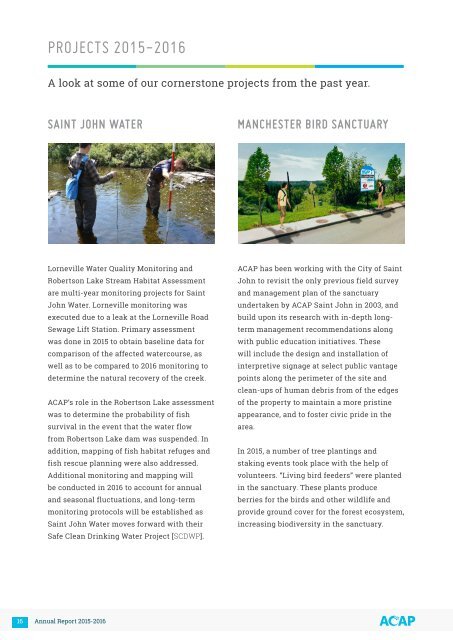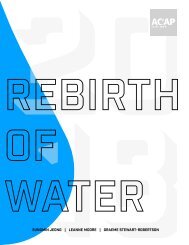Annual Report 2015-2016
ACAP Saint John Annual Report 2015-2016
ACAP Saint John Annual Report 2015-2016
You also want an ePaper? Increase the reach of your titles
YUMPU automatically turns print PDFs into web optimized ePapers that Google loves.
PROJECTS <strong>2015</strong>-<strong>2016</strong><br />
A look at some of our cornerstone projects from the past year.<br />
SAINT JOHN WATER<br />
MANCHESTER BIRD SANCTUARY<br />
Lorneville Water Quality Monitoring and<br />
Robertson Lake Stream Habitat Assessment<br />
are multi-year monitoring projects for Saint<br />
John Water. Lorneville monitoring was<br />
executed due to a leak at the Lorneville Road<br />
Sewage Lift Station. Primary assessment<br />
was done in <strong>2015</strong> to obtain baseline data for<br />
comparison of the affected watercourse, as<br />
well as to be compared to <strong>2016</strong> monitoring to<br />
determine the natural recovery of the creek.<br />
ACAP’s role in the Robertson Lake assessment<br />
was to determine the probability of fish<br />
survival in the event that the water flow<br />
from Robertson Lake dam was suspended. In<br />
addition, mapping of fish habitat refuges and<br />
fish rescue planning were also addressed.<br />
Additional monitoring and mapping will<br />
be conducted in <strong>2016</strong> to account for annual<br />
and seasonal fluctuations, and long-term<br />
monitoring protocols will be established as<br />
Saint John Water moves forward with their<br />
Safe Clean Drinking Water Project [SCDWP].<br />
ACAP has been working with the City of Saint<br />
John to revisit the only previous field survey<br />
and management plan of the sanctuary<br />
undertaken by ACAP Saint John in 2003, and<br />
build upon its research with in-depth longterm<br />
management recommendations along<br />
with public education initiatives. These<br />
will include the design and installation of<br />
interpretive signage at select public vantage<br />
points along the perimeter of the site and<br />
clean-ups of human debris from of the edges<br />
of the property to maintain a more pristine<br />
appearance, and to foster civic pride in the<br />
area.<br />
In <strong>2015</strong>, a number of tree plantings and<br />
staking events took place with the help of<br />
volunteers. “Living bird feeders” were planted<br />
in the sanctuary. These plants produce<br />
berries for the birds and other wildlife and<br />
provide ground cover for the forest ecosystem,<br />
increasing biodiversity in the sanctuary.<br />
16 <strong>Annual</strong> <strong>Report</strong> <strong>2015</strong>-<strong>2016</strong>

















